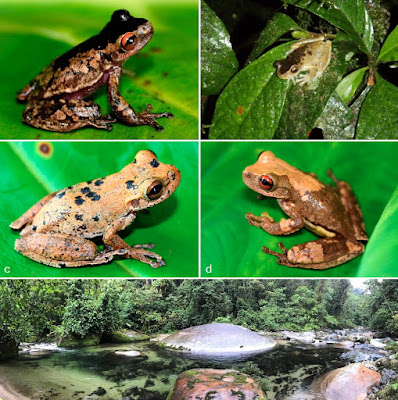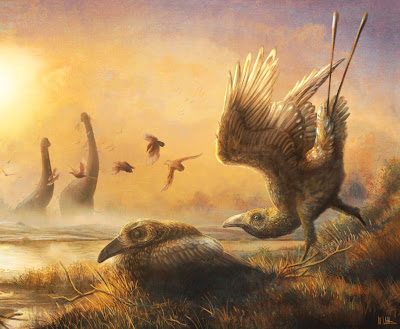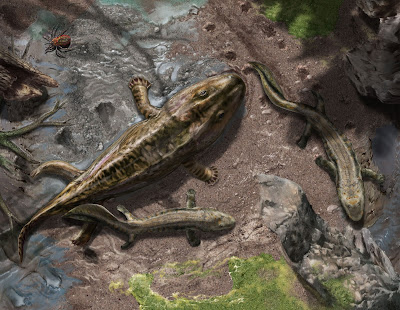[Most Recent Entries] [Calendar View]
Thursday, November 26th, 2020
| Time | Event | ||
| 2:07a | [Herpetology • 2020] Atlantihyla melissa • A Critically Endangered New Species of Polymorphic Stream Frog (Anura: Hylidae: Atlantihyla) from the Montane Rainforest of Refugio de Vida Silvestre Texiguat, Honduras
The Chortís Highlands of Mesoamerica exhibit a high degree of in situ evolutionary diversification, exemplified by numerous endemic radiations of stream-dwelling treefrogs (Anura: Hylidae: Atlantihyla, Duellmanohyla, and Ptychohyla), which have been a source of ongoing taxonomic uncertainty. Recent evidence suggests that one species, Atlantihyla spinipollex, may conceal an unrecognized sister species found in Refugio de Vida Silvestre Texiguat. We applied an iterative integrative taxonomic framework to assess this population within the context of Chortís Highlands populations of Atlantihyla spinipollex sensu stricto, Duellmanohyla salvadorensis, D. salvavida, D. soralia, and Ptychohyla hypomykter, using both a single locus (mtDNA: 16S) and multilocus (mtDNA: 12S, 16S; nDNA: POMC, RAG-1, Rhodopsin) datasets accompanied by distance- and tree-based species delimitation methods to inform our taxonomy. Samples of A. spinipollex sensu lato formed two deeply divergent monophyletic lineages, suggesting that populations from the central and eastern Cordillera Nombre de Dios are conspecific, while the population from Refugio de Vida Silvestre Texiguat represents a previously undescribed species. We analyzed morphological and bioacoustic variation within and between the two lineages of A. spinipollex sensu lato and found support for recognition of two distinct taxa. We restricted the name A. spinipollex to populations in the central and eastern Cordillera Nombre de Dios, and formally describe the Texiguat population as a new species. We recommend the new species be considered Critically Endangered due to ongoing habitat loss within what remains of its highly restricted natural distribution. This new species joins 26 other endemic species of amphibians and reptiles at Texiguat. Key words: Atlantihyla melissa sp. nov., Atlantihyla spinipollex, Chortís Block Highlands, Cordillera Nombre de Dios, Ptychohyla hypomykter, Refugio de Vida Silvestre Texiguat. Atlantihyla melissa sp. nov. Etymology. We name this species in honor of our friend and collaborator, Isis Melissa Medina-Flores, a feld biologist originally from Mangulile in the Department of Olancho, Honduras. Melissa participated in the discovery and description of this new species, two other Texiguat endemics: the palm-pitviper Bothriechis guifarroi Townsend, Medina-Flores, Wilson, Jadin & Austin, 2013, and the centipede snake Tantilla olympia Townsend, Wilson, Medina-Flores & Herrera-B., 2013; and two salamanders endemic to the Department of Olancho: Nototriton mime Townsend, Medina-Flores, Reyes-Calderón & Austin, 2013, and N. picucha Townsend, Medina-Flores, Murillo, and Austin, 2011. Melissa disappeared without a trace on 5 November 2016, after becoming separated from her companions while descending from the summit of the highest peak in Honduras, Cerro de Las Minas in Parque Nacional Celaque. Despite over a month of continuous searching by military and volunteer rescue teams supported by search dogs and aircraft, no evidence of Melissa’s fate has been found. Josiah H. Townsend, Luis A. Herrera-B., Erich P. Hofmann, Ileana R. LuqueMontes, Ayla N. Ross, Daniel Dudek, Jr., Catherine Krygeris, Joseph E. Duchamp and Larry David Wilson. 2020. A Critically Endangered New Species of Polymorphic Stream Frog (Anura: Hylidae: Atlantihyla) from the Montane Rainforest of Refugio de Vida Silvestre Texiguat, Honduras. Vertebrate Zoology. 70(4): 731-756. DOI: 10.26049/VZ70-4-2020-12 Description (es): Las tierras altas Chortís en Centro América presentan un alto grado de diversificación evolutiva in situ, demostrado por un numero de radiaciones endémicas de ranas arborícolas asociadas con ecosistemas lóticos (Anura: Hylidae: Atlantihyla, Duellmanohyla y Ptychohyla), y previamente han sido fuente de incertidumbre. Evidencia reciente sugiere que una especie, Atlantihyla spinipollex, podría ocultar un especie hermana no reconocida, en el Refugio de Vida Silvestre Texiguat. Aplicamos un modelo iterativo taxonómico integrativo para evaluar esta población dentro del contexto de las poblaciones de las Tierras Altas Chortís de Atlantihyla spinipollex sensu stricto, Duellmanohyla salvadorensis, D. salvavida, D. soralia, y Ptychohyla hypomykter, utilizando ambos, conjuntos de datos con locus génicos individuales (mtDNA: 16S) y conjuntos de datos con múltiple loci (mtDNA: 12S, 16S; nDNA: POMC, RAG-1, Rhodopsin), acompañados por métodos de delimitación de especies basados en distancia y arboles filogenéticos. Las muestras de A. spinipollex sensu lato formaron dos linajes monofiléticos profundamente divergentes, sugiriendo que las poblaciones del centro y Este de la Cordillera Nombre de Dios son conspecíficas, mientras que la población del Refugio de Vida Silvestre Texiguat representa un linaje a nivel de especie no descrito previamente. Analizamos la variación morfológica y bioacústica dentro y entre los dos linajes de A. spinipollexsensu lato y encontramos un fuerte soporte estadístico para el reconocimiento de dos taxones distintos. Restringimos el nombre A. spinipollex a las poblaciónes del centro y el Este de la Cordillera Nombre de Dios, y formalmente describimos la población del Refugio de Vida Silvestre Texiguat como una especie nueva. Recomendamos que la nueva especies sea considerada En Peligro Critico debido a la amenaza inmediata y continua de pérdida de hábitat dentro de su distribución natural altamente restringida. Esta nueva especie se une a otras 26 especies endémicas de anfibios y reptiles en Texiguat. | ||
| 2:31a | [PaleoOrnithology • 2020] Falcatakely forsterae • Late Cretaceous Bird from Madagascar reveals Unique Development of Beaks
Abstract Mesozoic birds display considerable diversity in size, flight adaptations and feather organization, but exhibit relatively conserved patterns of beak shape and development. Although Neornithine (that is, crown group) birds also exhibit constraint on facial development, they have comparatively diverse beak morphologies associated with a range of feeding and behavioural ecologies, in contrast to Mesozoic birds. Here we describe a crow-sized stem bird, Falcatakely forsterae gen. et sp. nov., from the Late Cretaceous epoch of Madagascar that possesses a long and deep rostrum, an expression of beak morphology that was previously unknown among Mesozoic birds and is superficially similar to that of a variety of crown-group birds (for example, toucans). The rostrum of Falcatakely is composed of an expansive edentulous maxilla and a small tooth-bearing premaxilla. Morphometric analyses of individual bony elements and three-dimensional rostrum shape reveal the development of a neornithine-like facial anatomy despite the retention of a maxilla–premaxilla organization that is similar to that of nonavialan theropods. The patterning and increased height of the rostrum in Falcatakely reveals a degree of developmental lability and increased morphological disparity that was previously unknown in early branching avialans. Expression of this phenotype (and presumed ecology) in a stem bird underscores that consolidation to the neornithine-like, premaxilla-dominated rostrum was not an evolutionary prerequisite for beak enlargement. Patrick M. O’Connor, Alan H. Turner, Joseph R. Groenke, Ryan N. Felice, Raymond R. Rogers, David W. Krause and Lydia J. Rahantarisoa. 2020. Late Cretaceous Bird from Madagascar reveals Unique Development of Beaks. Nature. DOI: 10.1038/s41586-020-2945-x | ||
| 11:42a | [Paleontology • 2020] Functional Adaptive Landscapes Predict Terrestrial Capacity at the Origin of Limbs Abstract The acquisition of terrestrial, limb-based locomotion during tetrapod evolution has remained a subject of debate for more than a century. Our current understanding of the locomotor transition from water to land is largely based on a few exemplar fossils such as Tiktaalik, Acanthostega, Ichthyostega and Pederpes. However, isolated bony elements may reveal hidden functional diversity, providing a more comprehensive evolutionary perspective. Here we analyse 40 three-dimensionally preserved humeri from extinct tetrapodomorphs that span the fin-to-limb transition and use functionally informed ecological adaptive landscapes to reconstruct the evolution of terrestrial locomotion. We show that evolutionary changes in the shape of the humerus are driven by ecology and phylogeny and are associated with functional trade-offs related to locomotor performance. Two divergent adaptive landscapes are recovered for aquatic fishes and terrestrial crown tetrapods, each of which is defined by a different combination of functional specializations. Humeri of stem tetrapods share a unique suite of functional adaptations, but do not conform to their own predicted adaptive peak. Instead, humeri of stem tetrapods fall at the base of the crown tetrapod landscape, indicating that the capacity for terrestrial locomotion occurred with the origin of limbs. Our results suggest that stem tetrapods may have used transitional gaits during the initial stages of land exploration, stabilized by the opposing selective pressures of their amphibious habits. Effective limb-based locomotion did not arise until loss of the ancestral ‘L-shaped’ humerus in the crown group, setting the stage for the diversification of terrestrial tetrapods and the establishment of modern ecological niches. Blake V. Dickson, Jennifer A. Clack, Timothy R. Smithson and Stephanie E. Pierce. 2020. Functional Adaptive Landscapes Predict Terrestrial Capacity at the Origin of Limbs. Nature. DOI: 10.1038/s41586-020-2974-5 Water-to-land transition in early tetrapods A new study answers the debate: how terrestrial were early tetrapods? |
| << Previous Day |
2020/11/26 [Calendar] |
Next Day >> |

























